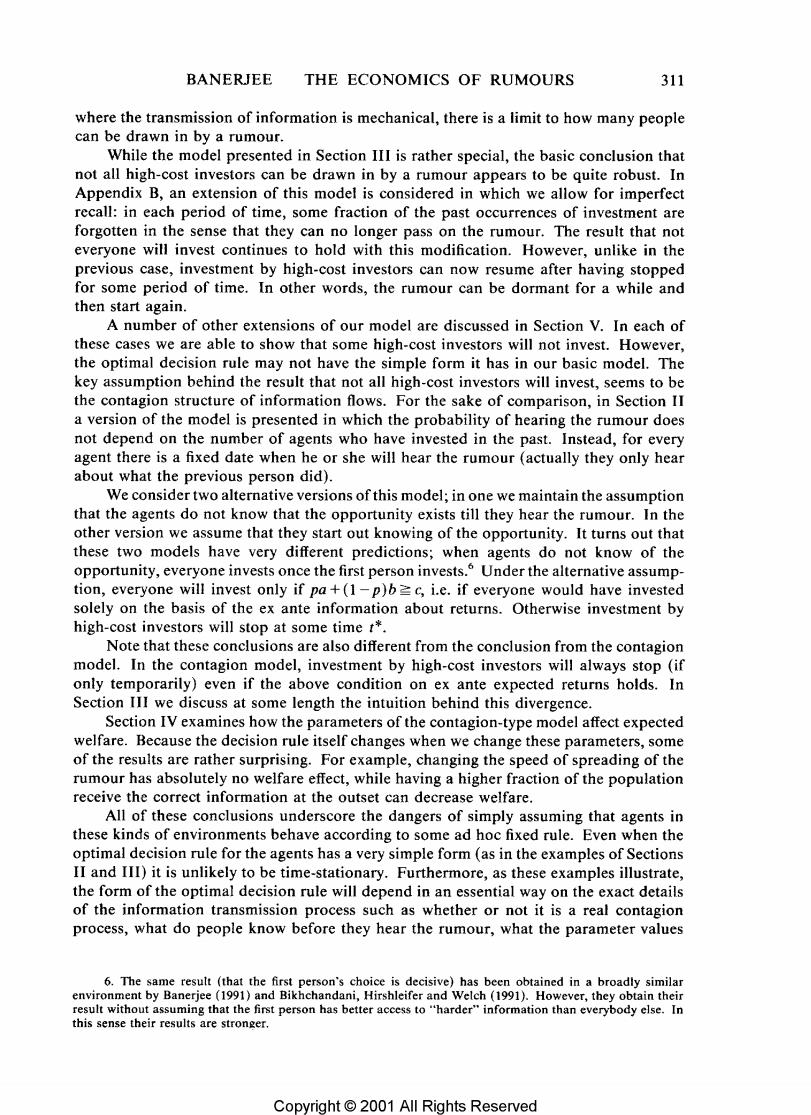正在加载图片...

BANERJEE THE ECONOMICS OF RUMOURS 311 where the transmission of information is mechanical,there is a limit to how many people can be drawn in by a rumour. While the model presented in Section III is rather special,the basic conclusion that not all high-cost investors can be drawn in by a rumour appears to be quite robust.In Appendix B,an extension of this model is considered in which we allow for imperfect recall:in each period of time,some fraction of the past occurrences of investment are forgotten in the sense that they can no longer pass on the rumour.The result that not everyone will invest continues to hold with this modification.However,unlike in the previous case,investment by high-cost investors can now resume after having stopped for some period of time.In other words,the rumour can be dormant for a while and then start again. A number of other extensions of our model are discussed in Section V.In each of these cases we are able to show that some high-cost investors will not invest.However, the optimal decision rule may not have the simple form it has in our basic model.The key assumption behind the result that not all high-cost investors will invest,seems to be the contagion structure of information flows.For the sake of comparison,in Section II a version of the model is presented in which the probability of hearing the rumour does not depend on the number of agents who have invested in the past.Instead,for every agent there is a fixed date when he or she will hear the rumour (actually they only hear about what the previous person did). We consider two alternative versions of this model;in one we maintain the assumption that the agents do not know that the opportunity exists till they hear the rumour.In the other version we assume that they start out knowing of the opportunity.It turns out that these two models have very different predictions;when agents do not know of the opportunity,everyone invests once the first person invests.Under the alternative assump- tion,everyone will invest only if pa+(1-p)b=c,i.e.if everyone would have invested solely on the basis of the ex ante information about returns.Otherwise investment by high-cost investors will stop at some time t*. Note that these conclusions are also different from the conclusion from the contagion model.In the contagion model,investment by high-cost investors will always stop (if only temporarily)even if the above condition on ex ante expected returns holds.In Section IlI we discuss at some length the intuition behind this divergence. Section IV examines how the parameters of the contagion-type model affect expected welfare.Because the decision rule itself changes when we change these parameters,some of the results are rather surprising.For example,changing the speed of spreading of the rumour has absolutely no welfare effect,while having a higher fraction of the population receive the correct information at the outset can decrease welfare. All of these conclusions underscore the dangers of simply assuming that agents in these kinds of environments behave according to some ad hoc fixed rule.Even when the optimal decision rule for the agents has a very simple form(as in the examples of Sections II and III)it is unlikely to be time-stationary.Furthermore,as these examples illustrate, the form of the optimal decision rule will depend in an essential way on the exact details of the information transmission process such as whether or not it is a real contagion process,what do people know before they hear the rumour,what the parameter values 6.The same result (that the first person's choice is decisive)has been obtained in a broadly similar environment by Banerjee(1991)and Bikhchandani,Hirshleifer and Welch(1991).However,they obtain their result without assuming that the first person has better access to"harder"information than everybody else.In this sense their results are stronger. Copyright 2001 All Rights Reserved